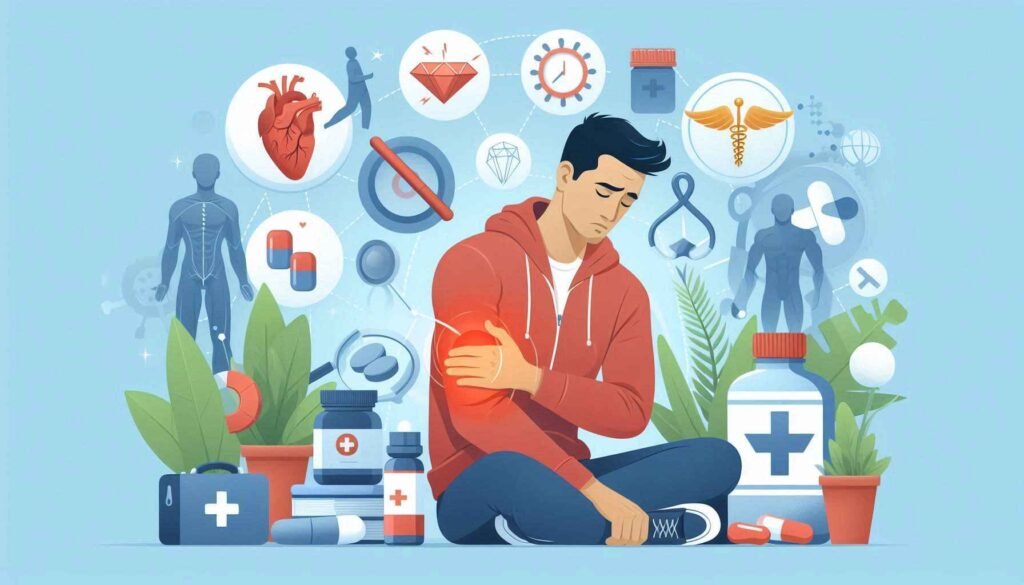
Managing Chronic Pain: Lifestyle Tips and Treatment Options
Chronic pain is a daily struggle for millions of people worldwide. Whether it’s caused by an injury, an illness like arthritis, or has no clear origin, living with chronic pain can drastically affect your physical and emotional well-being. Pain that lasts longer than three months is typically categorized as chronic and requires a holistic approach to management. While medication can offer relief, lifestyle changes play a significant role in controlling and easing chronic pain. In this comprehensive guide, we’ll explore various lifestyle tips and treatment options to help you take control of your pain and improve your quality of life.
Understanding Chronic Pain
Chronic pain isn’t just about physical discomfort—it can affect your mental and emotional health as well. It’s often described as a persistent, nagging pain that doesn’t go away even after healing from an injury or illness. Common conditions associated with chronic pain include arthritis, back pain, fibromyalgia, nerve damage, and post-surgical complications.
One challenge in managing chronic pain is the complexity of the body’s pain pathways. Over time, pain can become more widespread as your central nervous system becomes more sensitive, a process known as central sensitization. This means that even after the initial cause of the pain has been treated, your brain may continue to send pain signals. Understanding that chronic pain is not just a symptom but a condition in itself is key to managing it effectively.
The Role of Lifestyle in Chronic Pain Management
Many factors contribute to chronic pain, but some of the biggest drivers are lifestyle choices such as diet, physical activity, stress, and sleep. Adjusting these factors can have a significant impact on reducing pain. Unlike medication, which may only target the pain directly, lifestyle changes can improve your overall health and address the underlying causes of pain, such as inflammation and poor circulation.
In fact, research shows that chronic pain is perpetuated by five key lifestyle factors: stress, physical inactivity, poor sleep, an unhealthy diet, and smoking. Addressing these factors can not only reduce pain but also improve your mental health and increase your energy levels.
1. Stress Management
Stress can be a major trigger for chronic pain. When you’re stressed, your muscles tense up, which can worsen pain. Over time, this can lead to a vicious cycle where pain causes stress, and stress increases the perception of pain. Learning how to manage stress effectively is crucial for breaking this cycle.
Practical Tips for Stress Management:
- Meditation and Mindfulness: Mindfulness practices encourage focusing on the present moment without judgment. This simple technique has been proven to reduce stress and improve how your brain processes pain.
- Breathing Exercises: Deep, controlled breathing can reduce muscle tension and calm the nervous system. Try inhaling slowly through your nose, allowing your lungs to expand, and then exhaling through your mouth.
- Engage in Hobbies: Find activities that bring you joy and relaxation. Whether it’s reading, painting, or gardening, making time for leisure can lower stress levels and reduce pain.
2. Physical Activity: Move to Heal
Exercise may seem counterintuitive when you’re in pain, but staying active is one of the best things you can do to manage chronic pain. Regular physical activity strengthens muscles, improves flexibility, and boosts circulation, all of which help reduce pain. It also triggers the release of endorphins—your body’s natural painkillers.
What Type of Exercise is Best?
Low-impact activities like walking, swimming, and yoga are excellent for people with chronic pain. Start slow and gradually increase your activity level. Working with a physical therapist can also help you design a program tailored to your specific needs.
Benefits of Physical Activity for Pain Management:
- Strengthens muscles: Supporting muscles can reduce the pressure on joints, easing pain from conditions like arthritis.
- Increases flexibility: Stretching and movement prevent stiffness, which can worsen pain.
- Boosts mental health: Physical activity releases endorphins, which can lift your mood and reduce the perception of pain.
3. Prioritizing Sleep: Rest to Recover
Chronic pain and sleep problems often go hand-in-hand. Pain can make it difficult to sleep, and poor sleep can make the pain feel worse the next day. Research has shown that sleep deprivation increases sensitivity to pain and lowers your pain threshold.
Sleep Hygiene Tips:
- Establish a Consistent Routine: Go to bed and wake up at the same time every day, even on weekends. Consistency helps regulate your body’s internal clock.
- Create a Sleep-Friendly Environment: Make sure your bedroom is dark, quiet, and cool. Consider using blackout curtains or earplugs if necessary.
- Avoid Stimulants: Stay away from caffeine and electronics close to bedtime. Both can interfere with your ability to fall asleep.
By improving your sleep habits, you’ll help your body recover and reduce pain levels.
4. Nutrition for Pain Reduction
What you eat can either help or hinder your pain management. A healthy, balanced diet rich in anti-inflammatory foods can reduce pain levels and promote overall well-being. Inflammation is a key factor in chronic pain, especially for conditions like arthritis and fibromyalgia.
Anti-Inflammatory Foods to Incorporate:
- Omega-3 Fatty Acids: Found in fish like salmon and flaxseeds, omega-3s have been shown to reduce inflammation and pain.
- Fruits and Vegetables: Rich in antioxidants, these foods help fight inflammation and repair damaged tissues.
- Whole Grains: Foods like brown rice and quinoa provide nutrients that promote healthy muscle function and reduce inflammation.
In addition to eating more anti-inflammatory foods, staying hydrated is essential. Proper hydration supports muscle function and can help reduce muscle pain and stiffness.
5. Smoking and Alcohol: Know the Risks
Both smoking and excessive alcohol consumption can worsen chronic pain. Smoking decreases blood flow and oxygen to tissues, slowing down the healing process. It also increases pain sensitivity and can interfere with medications used to manage pain. If you smoke, quitting is one of the best steps you can take to reduce pain.
Similarly, alcohol can disrupt sleep and increase inflammation, making pain worse. While moderate alcohol consumption may not have a significant impact, limiting your intake can lead to better pain management and overall health.
6. Alternative Therapies for Pain Relief
In addition to lifestyle changes, several alternative therapies can complement your pain management routine. These non-invasive treatments can be effective for reducing pain without the side effects associated with medications.
Acupuncture:
Acupuncture, a traditional Chinese medicine technique, involves inserting thin needles into specific points on the body. Research suggests that acupuncture can stimulate the central nervous system, releasing chemicals that ease pain.
Massage Therapy:
Massage therapy can help relieve muscle tension, reduce stress, and promote relaxation—all of which can ease chronic pain. Regular massages may improve blood flow and reduce inflammation, offering a natural way to manage pain.
Heat and Cold Therapy:
Applying heat or cold to painful areas can provide immediate relief. Cold therapy reduces inflammation and numbs the area, while heat therapy relaxes muscles and promotes healing. Alternating between the two can be especially effective.
Conclusion: Take Control of Your Pain
Chronic pain doesn’t have to control your life. By making positive lifestyle changes and incorporating alternative therapies, you can manage your pain and improve your quality of life. While medical treatments are an important part of pain management, lifestyle modifications such as reducing stress, exercising, eating a healthy diet, and getting better sleep can have a profound impact on your pain levels.
It’s important to remember that everyone’s pain is different, and what works for one person may not work for another. Consult with healthcare professionals to develop a pain management plan tailored to your specific needs. With the right approach, you can take control of your pain and lead a healthier, happier life.



